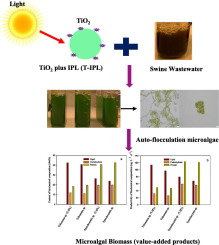当前位置:
X-MOL 学术
›
Sci. Total Environ.
›
论文详情
Our official English website, www.x-mol.net, welcomes your
feedback! (Note: you will need to create a separate account there.)
Auto-flocculation microalgae species Tribonema sp. and Synechocystis sp. with T-IPL pretreatment to improve swine wastewater nutrient removal.
Science of the Total Environment ( IF 8.2 ) Pub Date : 2020-04-07 , DOI: 10.1016/j.scitotenv.2020.138263 Pengfei Cheng 1 , Dongjie Chen 2 , Wei Liu 3 , Kirk Cobb 2 , Nan Zhou 2 , Yuhuan Liu 4 , Hui Liu 5 , Qin Wang 5 , Paul Chen 2 , Chengxu Zhou 6 , Roger Ruan 2
Science of the Total Environment ( IF 8.2 ) Pub Date : 2020-04-07 , DOI: 10.1016/j.scitotenv.2020.138263 Pengfei Cheng 1 , Dongjie Chen 2 , Wei Liu 3 , Kirk Cobb 2 , Nan Zhou 2 , Yuhuan Liu 4 , Hui Liu 5 , Qin Wang 5 , Paul Chen 2 , Chengxu Zhou 6 , Roger Ruan 2
Affiliation

|
It is recognized coupling microalgae, which is rich in lipids or protein with wastewater treatment offers extra economic benefits that can potentially make microalgal production feasible by reducing production costs and providing environmental benefits. However, the pretreatment of high concentration nutrients such as ammonia nitrogen (NH3-N), total phosphorus (TP) and chemical oxygen demand (COD) in swine wastewater is the premise of application for microalgae in wastewater treatment. This study two auto-flocculation microalgae Tribonema sp. and Synechocystis sp. were selected for evaluation; they were cultivated in diluted swine wastewater together after it was pretreated with titanium dioxide (TiO2) plus intense pulsed light (T-IPL). The results showed that the growth of the two strains in the wastewater pretreated with T-IPL grew better than when grown without the pretreatment. The content of lipid in the two algae, cultured in the pretreated wastewater, was also higher than the lipid content from the un-pretreated wastewater; but protein content was lower. Overall, the removal efficiencies of pollutants NH3-N, TP, and COD by the two microalgae in anaerobic digestion of swine wastewater (ADSW) with T-IPL pretreatment, were higher than the removal efficiencies without pretreatment. This research also indicates that these two auto-flocculation microalgae have the potential to reduce harvesting costs. And, using T-IPL to pretreat wastewater could provide a promising method for the pretreatment of wastewater.
中文翻译:

自絮凝微藻物种Tribonema sp。和集胞藻 T-IPL预处理可改善猪废水中的营养去除率。
公认的是,将富含脂质或蛋白质的微藻类与废水处理相结合可提供额外的经济效益,可通过降低生产成本并提供环境效益来潜在地使微藻类生产可行。然而,猪废水中高浓度养分例如氨氮(NH3-N),总磷(TP)和化学需氧量(COD)的预处理是微藻在废水处理中应用的前提。本研究研究了两种自絮凝微藻Tribonema sp。和集胞藻 被选中进行评估;用二氧化钛(TiO2)和强脉冲光(T-IPL)预处理后,将它们在稀释的猪废水中一起培养。结果表明,两种菌株在用T-IPL预处理的废水中的生长要好于未经预处理的废水。在预处理废水中培养的两种藻类中的脂质含量也高于未预处理废水中的脂质含量。但蛋白质含量较低。总体而言,采用T-IPL预处理的两种微藻对猪废水(ADSW)进行厌氧消化时,污染物NH3-N,TP和COD的去除效率高于未经预处理的去除率。该研究还表明,这两种自絮凝微藻具有降低收获成本的潜力。而且,使用T-IPL预处理废水可以为废水的预处理提供有希望的方法。在预处理废水中培养的两种藻类中的脂质含量也高于未预处理废水中的脂质含量。但蛋白质含量较低。总体而言,采用T-IPL预处理的两种微藻对猪废水(ADSW)进行厌氧消化时,污染物NH3-N,TP和COD的去除效率高于未经预处理的去除率。该研究还表明,这两种自絮凝微藻具有降低收获成本的潜力。而且,使用T-IPL预处理废水可以为废水的预处理提供有前途的方法。在预处理废水中培养的两种藻类中的脂质含量也高于未预处理废水中的脂质含量。但蛋白质含量较低。总体而言,采用T-IPL预处理的两种微藻对猪废水(ADSW)进行厌氧消化时,污染物NH3-N,TP和COD的去除效率高于未经预处理的去除率。该研究还表明,这两种自絮凝微藻具有降低收获成本的潜力。而且,使用T-IPL预处理废水可以为废水的预处理提供有前途的方法。两种微藻在T-IPL预处理下对猪废水(ADSW)的厌氧消化中的COD和COD均高于未经预处理的去除效率。该研究还表明,这两种自絮凝微藻具有降低收获成本的潜力。而且,使用T-IPL预处理废水可以为废水的预处理提供有前途的方法。T-IPL预处理对猪粪废水(ADSW)的厌氧消化中两种微藻的COD和COD均高于未经预处理的去除效率。该研究还表明,这两种自絮凝微藻具有降低收获成本的潜力。而且,使用T-IPL预处理废水可以为废水的预处理提供有前途的方法。
更新日期:2020-04-08
中文翻译:

自絮凝微藻物种Tribonema sp。和集胞藻 T-IPL预处理可改善猪废水中的营养去除率。
公认的是,将富含脂质或蛋白质的微藻类与废水处理相结合可提供额外的经济效益,可通过降低生产成本并提供环境效益来潜在地使微藻类生产可行。然而,猪废水中高浓度养分例如氨氮(NH3-N),总磷(TP)和化学需氧量(COD)的预处理是微藻在废水处理中应用的前提。本研究研究了两种自絮凝微藻Tribonema sp。和集胞藻 被选中进行评估;用二氧化钛(TiO2)和强脉冲光(T-IPL)预处理后,将它们在稀释的猪废水中一起培养。结果表明,两种菌株在用T-IPL预处理的废水中的生长要好于未经预处理的废水。在预处理废水中培养的两种藻类中的脂质含量也高于未预处理废水中的脂质含量。但蛋白质含量较低。总体而言,采用T-IPL预处理的两种微藻对猪废水(ADSW)进行厌氧消化时,污染物NH3-N,TP和COD的去除效率高于未经预处理的去除率。该研究还表明,这两种自絮凝微藻具有降低收获成本的潜力。而且,使用T-IPL预处理废水可以为废水的预处理提供有希望的方法。在预处理废水中培养的两种藻类中的脂质含量也高于未预处理废水中的脂质含量。但蛋白质含量较低。总体而言,采用T-IPL预处理的两种微藻对猪废水(ADSW)进行厌氧消化时,污染物NH3-N,TP和COD的去除效率高于未经预处理的去除率。该研究还表明,这两种自絮凝微藻具有降低收获成本的潜力。而且,使用T-IPL预处理废水可以为废水的预处理提供有前途的方法。在预处理废水中培养的两种藻类中的脂质含量也高于未预处理废水中的脂质含量。但蛋白质含量较低。总体而言,采用T-IPL预处理的两种微藻对猪废水(ADSW)进行厌氧消化时,污染物NH3-N,TP和COD的去除效率高于未经预处理的去除率。该研究还表明,这两种自絮凝微藻具有降低收获成本的潜力。而且,使用T-IPL预处理废水可以为废水的预处理提供有前途的方法。两种微藻在T-IPL预处理下对猪废水(ADSW)的厌氧消化中的COD和COD均高于未经预处理的去除效率。该研究还表明,这两种自絮凝微藻具有降低收获成本的潜力。而且,使用T-IPL预处理废水可以为废水的预处理提供有前途的方法。T-IPL预处理对猪粪废水(ADSW)的厌氧消化中两种微藻的COD和COD均高于未经预处理的去除效率。该研究还表明,这两种自絮凝微藻具有降低收获成本的潜力。而且,使用T-IPL预处理废水可以为废水的预处理提供有前途的方法。











































 京公网安备 11010802027423号
京公网安备 11010802027423号